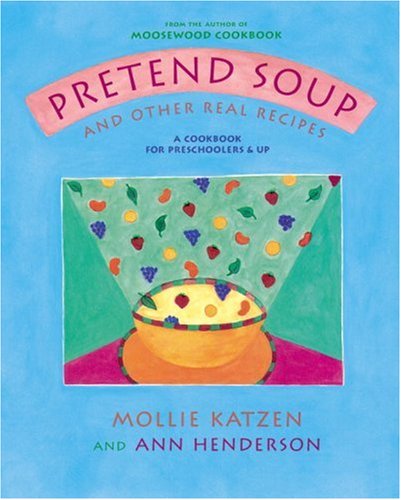Kids in the Kitchen!
June 10, 2014 by SusieEvery once in a while I like to catch up with what’s going on with kids’ cookbooks. I’ve looked at cookbooks for little kids (both story-based and picture-based) and cookbooks meant for teens. And, of course, family cookbooks, which tend to keep a laserlike focus on Getting It Done on a Weeknight.
Yet for a long time, I wasn’t finding that these cookbooks played much of a role in my own family. Even though everyone here – whether age 54, 44, 13, or 8 – maintains a healthy obsession with food, the kid-oriented cookbooks seemed to hold no appeal for the kids. I’d leave them out casually in common areas, or read them at storytime, but that’s as far as it went. The little one, who is good with flour, would join me in a heartbeat if she saw I was on a baking project, but had no interest in following even a stripped-down recipe. The big one avoided the kitchen entirely unless something snackable was out, or he had to put away the dishes.
I had little interest in pushing them to cook, knowing that when you’re a kid, being forced to do something by someone who’s an expert at it is a pretty good recipe for hating it. I decided to worry about other stuff, like car repairs and tuition and blackfly aphids on my broad beans.
But recently, something started happening. The 13-year-old’s school year finished in the end of May. His school tablet computer was returned to the school’s tech department, and he suddenly found himself at home, faced with what I call the Gift of Boredom. He mooned around the house awhile, draping himself over furniture, pestering me while I worked, dipping in and out of a Game Of Thrones book.
I explained that he’d be making his own breakfast and lunch (cries of protest!) but that I’d help him if he needed me. He quickly got bored of his usual breakfast – eggs, scrambled flat and hard, with bacon – so I taught him mine, okonomiyaki. It’s just an egg batter plus whatever vegetables you have around, teased into a chunky pancake and glazed on one side. He started by mixing the flour and leavening and gradually progressed to chopping the vegetables, flipping the pancake (using a tart pan bottom), and cooking the sauce. His surprise and pride when he tasted his first okonomiyaki filled my heart – but I played it cool.
 We ate at the kitchen table,
where this season’s cookbooks were piled high. On top was The Soda Fountain, just sitting there waiting
for a bored teen’s eyes to fall on it. He flipped through the
pages, chewing thoughtfully. “These don’t look so hard.”
We ate at the kitchen table,
where this season’s cookbooks were piled high. On top was The Soda Fountain, just sitting there waiting
for a bored teen’s eyes to fall on it. He flipped through the
pages, chewing thoughtfully. “These don’t look so hard.”
I sipped my coffee.
“Mom, why do they call it an egg cream?”
“Dunno, what does it say?”
Then, “Mom, do we have citric acid?” Then, “Mom, what are blanched almonds?”
Before I knew it, my son who hates to cook had occupied the kitchen like it was the Western Front in 1945. This was a week ago. Since then, nearly every day has started with okonomiyaki. Syrup after syrup has filled the fridge. Dinner often ends with an egg cream. Ants have come exploring for sugar spills and the dishwasher’s running twice a day.
 Meanwhile, the 8-year-old
suddenly remembered about Pretend Soup, which I bought a year ago.
Post-Its were affixed. Ingredients were requested.
And now my precious Me Time at 5:00 – that is, me with my
cookbooks starting dinner while listening to the news and sipping
my bourbon/ginger beer – has been colonized for Projects.
Yesterday, a noodle pudding. The day before, a homemade
lemon lime soda.
Meanwhile, the 8-year-old
suddenly remembered about Pretend Soup, which I bought a year ago.
Post-Its were affixed. Ingredients were requested.
And now my precious Me Time at 5:00 – that is, me with my
cookbooks starting dinner while listening to the news and sipping
my bourbon/ginger beer – has been colonized for Projects.
Yesterday, a noodle pudding. The day before, a homemade
lemon lime soda.
I make faces. I nag people to put away their stuff. I swear when I’m trying to fit things in the fridge and there’s no room next to the mason jars full of syrup. But secretly, I’m overjoyed. Even if it doesn’t last – even if they grow up and go through a ramen phase or a bagel phase or a nothing-but-kale-chips-from-the-store phase – I still have a feeling that a seed’s been planted, somehow or other.
Just don’t tell the kids.
Categories
- All Posts (7079)
- Antipasto (2209)
- Author Articles (250)
- Book News (944)
- Cookbook Giveaways (996)
- Cookbook Lovers (262)
- Cooking Tips (116)
- Culinary News (299)
- Food Biz People (558)
- Food Online (800)
- Holidays & Celebrations (277)
- New Cookbooks (154)
- Recipes (1520)
- Shelf Life With Susie (231)
- What's New on EYB (134)
Archives
Latest Comments
- lexa25 on For the Love of Lemons by Letitia Clark – Giveaway
- lexa25 on Balli Balli – Cookbook Giveaway and Quick Bites
- charcb on For the Love of Lemons by Letitia Clark – Giveaway
- charcb on Balli Balli – Cookbook Giveaway and Quick Bites
- Jane on Introducing libraries to EYB at ALA
- fluffies on For the Love of Lemons by Letitia Clark – Giveaway
- Goulashgirl on Any way you slice it
- ChefClaireFVS on French at Heart – Cookbook Giveaway
- ChefClaireFVS on 20 Amici – 40 Ricette Cookbook Giveaway
- kitchen_chick on Salt Sugar MSG Cookbook Giveaway